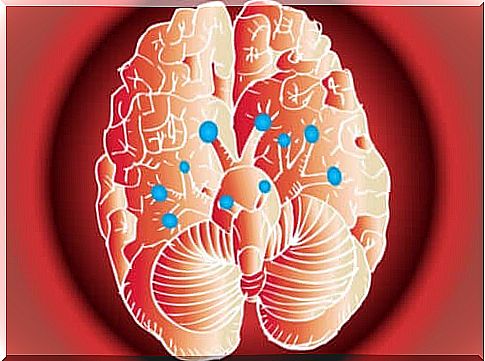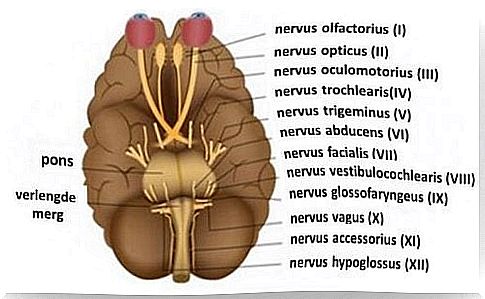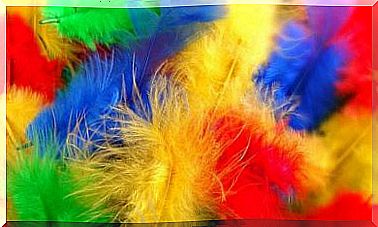Our Amazing Cranial Nerves And How They Work

Cranial nerves are also commonly referred to as cranial nerve pairs. This is simply because they are in pairs, one in each hemisphere of the brain.
The complexity of the nervous system is astonishing. Because of the many connections, this system is one of the most important systems in our body. So, in this article, we’ll talk about one of its most important parts: the cranial nerves.
The cranial nerves, or nerve pairs, emerge from the base of the skull and reach their target areas through small openings that spread throughout the skull. Thus they communicate with all peripheral areas. They get the name “pairing” because there is a nerve on both sides of the brain. There are twelve nerves in the right hemisphere and twelve nerves in the left hemisphere.
Classification of the cranial nerves
The cranial nerves can be classified in several ways:
According to their function
- Motor Cranial Nerves. Cranial nerves related to eye movements (3, 4 and 5) and to tongue and neck movements (10 and 12).
- Sensory cranial nerves. 1, 2, and 8.
- Mixed cranial nerves. 5, 7, 9, and 10.
- Parasympathetic cranial nerves. 3 and 7.
According to their position
Some are above the brainstem (pairs one and two), others in the upper part of the brainstem (pairs three and four), and still others near the bridge (pairs five, six, seven, and eight). Finally, there are also pairs in the lower part of the medulla oblongata (pairs nine, ten, eleven and twelve).
According to Bear, Connors, and Paradiso, authors of the book Neuroscience: Exploring the Brain , the first two cranial nerves are part of the central nervous system, and the others are just like the spinal nerves.
They argue that this is so “in the sense that they contain axons belonging to the peripheral nervous system.” Each of these nerves contains fibers that perform different functions.

The cranial nerves and their functions
Pair 1
Types of axons: special sensory ones.
This is the shortest pair because the target area is close to the area in the brain it originated from. It is also called the olfactory nerve. As the name implies, it is responsible for conveying information related to odors.
Pair 2
Types of axons: special sensory ones.
This nerve originates from the diencephalon, also called the interbrain. Like the previous one, it has afferent fibers that carry nerve impulses from the sensory organs to the central nervous system. Its function is to transmit visual information.
Pair 3
Types of axons: somatic motor and visceral motor.
This nerve is also known as the eye movement nerve. This is responsible for the movement of the eyes and eyelids. In addition, the parasympathetic has control over the size of the pupils.
Pair 4
Types of axons: somatic motor.
This fourth pair originates in the mesencephalon. It is also known as the pulley nerve. This controls the eyes and sends signals to the upper oblique muscle.
Pair 5
Types of axons: somatic sensory and somatic motor.
Also known as the triplet nerve, this pair has motor and sensory functions. First, it sends commands to the muscles responsible for chewing. Second , it also collects information about touch, pain, and proprioceptive information from the mouth and face.
Pair 6
Types of axons: somatic motor.
This cranial pair is responsible for moving the eye outward so that you can see past your nose. Isn’t that incredible?
Pair 7
Types of axons: somatic sensory and somatic motor.
This is also known as a face pair. This is due to the fact that it is responsible for the movements of the facial muscles. In addition, it gives the sense of taste to the upper part of the tongue. It also sends commands to the lacrimal and salivary glands.
Pair 8
Types of axons: special sensory ones.
This is also called hearing and balance nerve. It is responsible for hearing and balance. Also, this nerve is about receiving information about what we hear, and our physical location.
Pair 9
Types of axons: somatic motor, visceral motors, special sensory and visceral sensory motors.
This pair is also known as the lingual and pharyngeal nerve. It is a mixed nerve, and from its name we can deduce some of its functions:
- movement of the throat muscles
- parasympathetic control of the salivary glands
- detection of changes in blood pressure in the aorta
- sense of taste in the anterior third of the tongue

Pair 10
Types of axons: visceral motor.
This is also known as the floating nerve. It is responsible for the parasympathetic control of the heart, lungs and abdominal organs. In addition, it also controls the sensation of visceral pain, the movement of the throat muscles, as well as information about the taste.
Pair 11
Types of axons: somatic motor.
This is also known as the accessory nerve. This one is about throat and neck muscle movements.
Pair 12
Types of axons: somatic motor.
This cranial pair of nerves, the hypoglossal nerve, contributes to the action of swallowing. In addition, it is responsible for the movement of the tongue and works together with the cranial pairs 9 and 10. This ensures optimal swallowing.
As you can see, damage to the cranial nerves can cause serious problems for the functioning of our bodies. As a result of damage in the body, neurological disorders can manifest. We hope we’ve helped you understand and appreciate these vital nerves in our brain much more!









